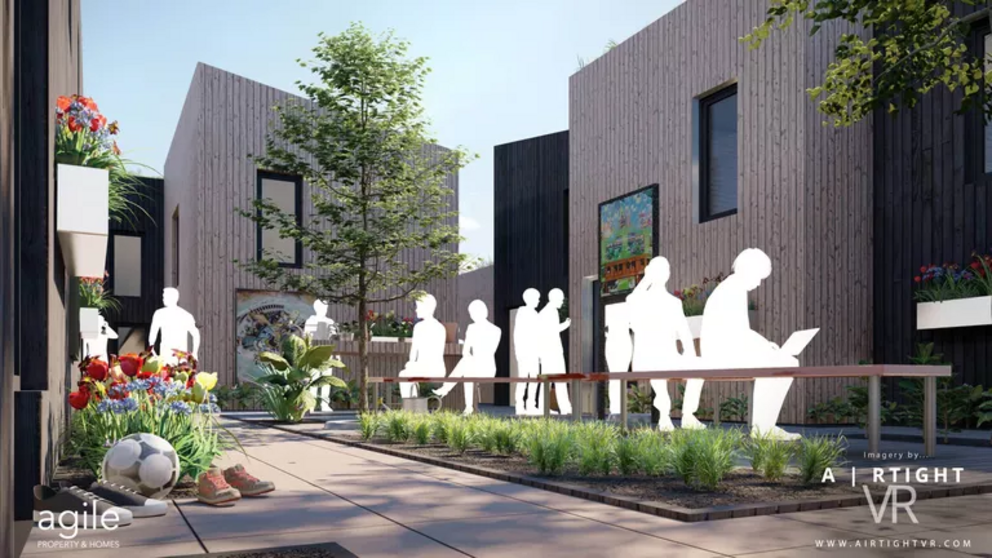
An agile approach to dealing with homelessness
Agile Homes builds low-carbon straw prefab homes and is now dropping them on rooftops.
Homelessness is a problem all over the world these days and many in the housing industry are looking at creative approaches to addressing it. Treehugger recently showed an American approach using shipping containers dropped in a field; in the United Kingdom, Craig White and his team at Agile Property and Homes are building prefabricated homes out of wood and straw, and are even dropping them on rooftops in Bristol.
White, who is also an architect, was behind ModCell, known to Treehugger for its prefabricated panels built of wood and insulated with 16 inches of straw. We noted previously that "the Modcell system combines the strength and stability of a timber structure with the insulating ability of straw, which is considerable. Straw is also totally renewable, a waste product, and cheap."
Agile Property and Homes is a development company set up by White; it is a startup that is a mix of ModCell technology and White's architectural practice. He tells Treehugger that their "model of prefabrication is not to do it from centralized factories but to unlock the potential of assembly using an international standard to manufacture in temporary facilities which might be somebody's warehouse to colloquially have 'flying factories' or technically, 'distributed manufacturing.'"
White notes that when making buildings, especially affordable homes, there are three components for a conventional developer. "You have to buy your land, you have to build your hardware, the homes or apartments, and sell them," he says. "Agile is based on the question, 'Can you do development without paying for land?' And the answer is, yes you can. We don't ever buy land, we unlock land that is free and hidden in plain sight."
Agile builds its units to the dimensions and rules of the Caravan Sites Act, British legislation that regulates what in the U.S. would be considered mobile or HUD homes. White says, "Because our units are mobile, we can lease land, rather than taking permanent ownership, and that is the magic that takes out roughly 35% of your development cost."
As a former real estate developer who tried to do projects similar to this almost 20 years ago in a market that was not quite ready for the concept, I can attest to the brilliance of this. Land is expensive to buy, but a lot of it is sitting around, waiting for approvals or zoning changes. These TAM units are legally not permanent buildings, even though they may end up being so–see PAD Studio's Chestnut Farm project, which was designed this way.
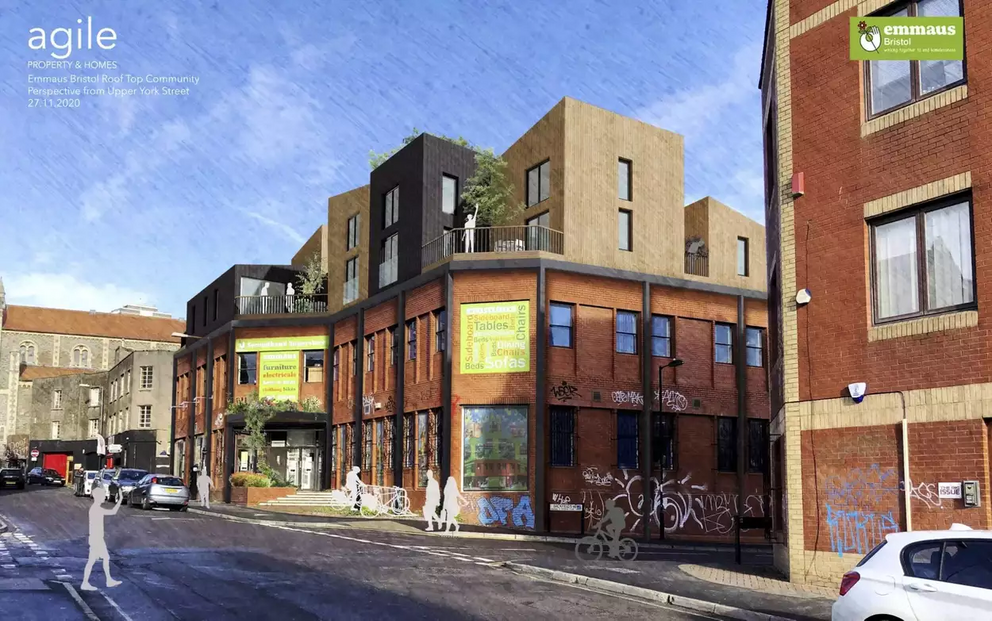 Agile Homes on roof of Emmaus Bristol building.
Agile Homes on roof of Emmaus Bristol building.And if you can't find land sitting around, there are millions of acres of rooftops. That's what Agile is doing in Bristol, with homelessness charity Emmaus Bristol. Agile writes:
"By utilising free land – the air space – on the roof of the charity’s office and retail space at Backfields House, Emmaus Bristol is hoping to create a new rooftop community. This will include 11 one-bedroom two storey homes, 3 two-bedroom single storey homes, 1 one-bedroom single story home, and food growing and shared amenity space."
https://youtu.be/QJcK_vmZYE8
This is again something I tried to do as a developer, proposing a tiny home community on the roof of a two-story building in Toronto, but ran into all kinds of engineering issues; the roof wasn't strong enough, and the building had to be reinforced for lateral wind and earthquake loads. White faced the same problems and explains those gray columns you see in the rendering are in fact legs supporting a table built on top of the building, an independent structure that supports the housing. This is in effect a land cost; that table is expensive but still cheaper than dirt. White notes:
“Working with Emmaus Bristol, we are pleased to have come up with a unique way to deliver low-carbon, affordable homes. Unlocking a land supply hidden in plain sight, in the heart of the City, on the rooftop of Backfields House, means we will be helping a new community come together in a place that will be beautiful, affordable and resilient.”
 Agile Single Module Unit.
Agile Single Module Unit.The TAM units are also available for purchase by the general public, for those who might want a caravan-legal home. This is a challenge, and the reason many entrepreneurs in the modern prefab world ended up broke. White and Agile avoid the worst risk by with the flying factory model; he notes correctly that "building a factory is the road to insolvency."
Trying to sell small modern prefabs without land is another path on the road to insolvency; not many people have a place to put a unit or understand the problems that they will face, or the costs of servicing. But without the overhead of a factory or a big sales team, Agile has a big advantage in this market. Having a great differentiated product helps.
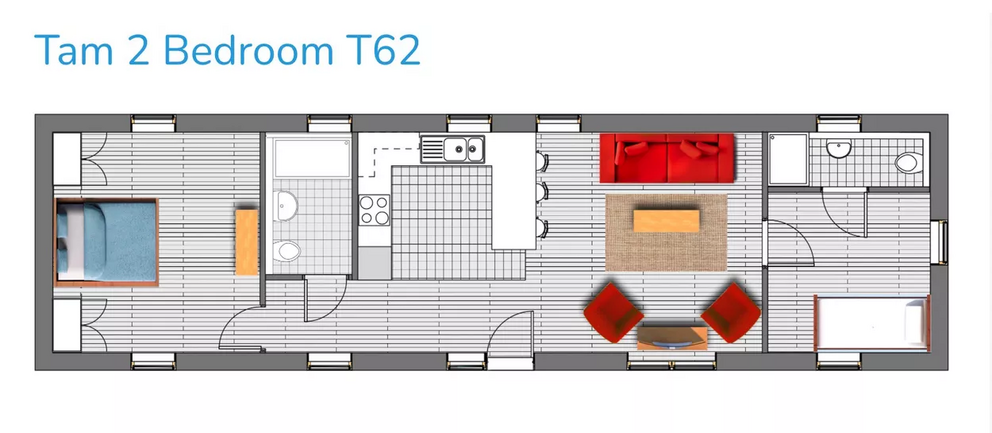 2 Bedroom Plan.
2 Bedroom Plan.It starts with a good set of plans that fit within the parameters of the Caravan Sites Act, which limits width and height and ensures that the units can travel. But unlike most caravan manufacturers—North Americans know caravans as trailers—Agile ships the unit flatpack in panels and assembles them on the first site, reducing the cost of shipping and avoiding the very expensive cost of the big crane needed to lift and place an assembled unit. That is a cost for the second move, not the first.
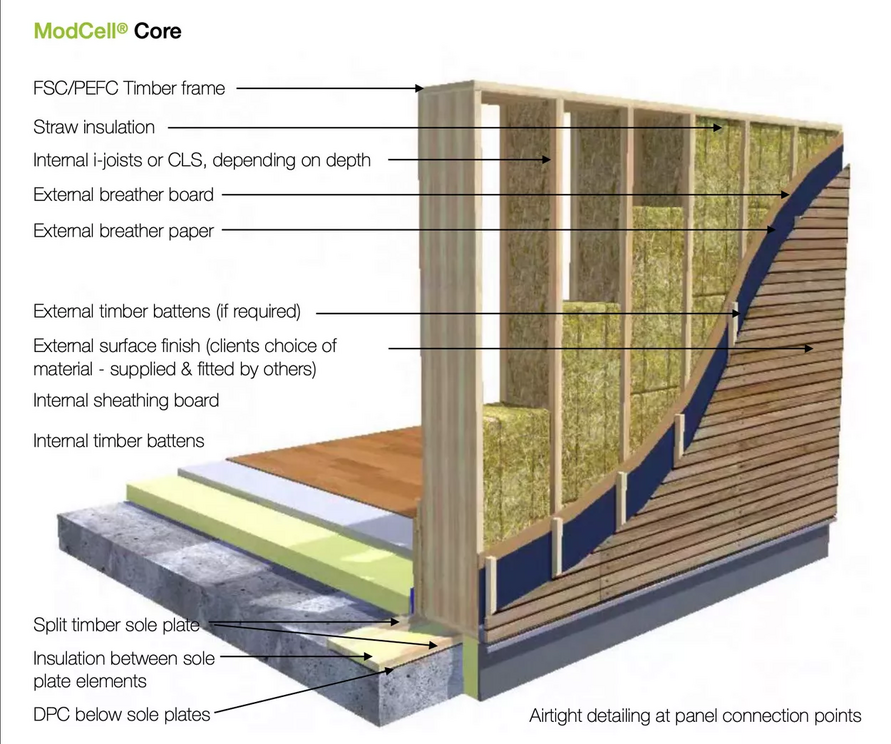 ModCell Panel (not used in Agile installation here).
ModCell Panel (not used in Agile installation here).It also helps to have a great sustainability story: The units are designed to the Passivhaus standard so they need almost no energy to operate. But also, by building out of wood and straw, there is an upfront carbon story to tell.
"Straw sequesters CO2 by the process of photosynthesis: in this, plants absorb CO2 from the atmosphere. They use the carbon to make cellulose and return the oxygen to atmosphere. Photosynthesis is bio-evolved, solar powered carbon capture with a by-product – oxygen. Tam is built with this captured carbon. A 1 bed Tam unit will sequester around 20,000 kg of CO2. As a result the Tam is a truly less than zero carbon building, which is good for the environment."
 Interior of Tam.
Interior of Tam.I have to add a personal note here. My resume page on Treehugger notes I have been an architect, a real estate developer, and a promoter of tiny homes and prefabricated housing. I have tried to do much of what Agile is doing, and I did almost everything wrong—a major reason that I am now a writer. I look at what Agile is doing and I am very impressed because based on what I learned, they are doing almost everything right.
- I tried to sell to individual purchasers while Agile is really focusing on the social and affordable housing sector, which means Agile doesn't have to deal with that pesky third component that conventional developers face: selling the units.
- I worked with a fixed factory, with had a limited radius that it could service; shipping and installing modular housing is expensive. Agile builds its panels where the business is. This has benefits for Agile, and for the community. They note: "We will utilise local labour and skills, but also provide opportunity for people to develop skills and experience. We tap into the resources offered by the local community."
- I tried to sell big modular boxes; Agile goes in flatpack, which "means that Tams can be delivered in locations, such as back gardens and under-used space, where other housebuilders will not go."
- I tried to sell a well-designed but basically upgraded version of conventional modular housing; Agile goes full tilt with a Passivhaus design built out of straw, as healthy and as green as it can be. It is truly a differentiated product.
Agile is, on the other hand, agile. It keeps its overhead low, and while it is selling units to the public, it appears to be focusing on the affordable and social housing sectors. These are the people who have the need and understand the product. The lightbulb moment was when White defined three legs of conventional real estate development: "You have to buy your land, you have to build the homes or apartments, and you have to sell them." He could have added a fourth: You have to borrow a ton of money to finance it all.
Agile does none of these things. It's brilliant.
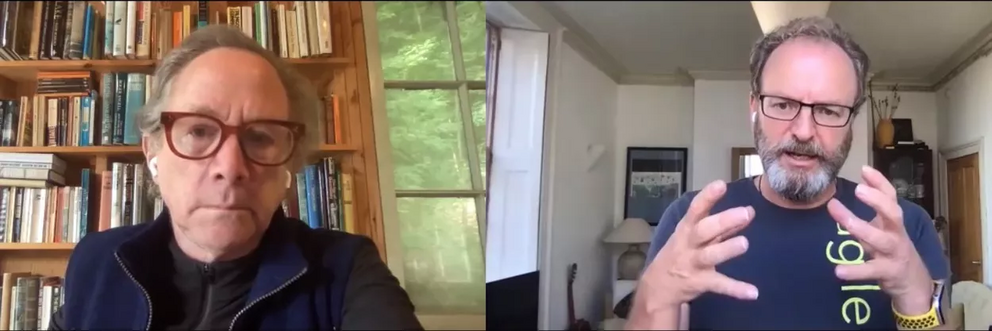 Lloyd Alter and Craig White.
Lloyd Alter and Craig White.In our Zoom chat, White and I briefly discussed another prefab company, Katerra, that recently folded after blowing through about $2 billion of investment.
When I first wrote about it, I was dubious, concluding: "I really, really want Katerra to succeed. I really want their CLT construction to take over the world. But I have seen this movie before. In fact, it gets remade every generation."
I have watched dozens of companies and individuals like myself fail at this, and Agile is not another remake. It is a modest, thoughtful approach to building truly sustainable housing that meets a real need, that deserves to succeed, and likely will.
For the rest of this article please go to source link below.
https://nexusnewsfeed.com/article/self-sufficiency/an-agile-approach-to-dealing-with-homelessness
Thanks to: https://nexusnewsfeed.com






 Sat Mar 23, 2024 11:33 pm by globalturbo
Sat Mar 23, 2024 11:33 pm by globalturbo

